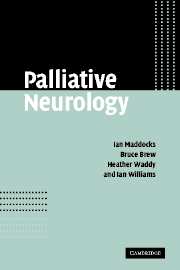Book contents
- Frontmatter
- Contents
- Foreword
- Note on drugs and abbreviations
- Section I Palliative Management
- Section II Major discomforts in advanced neurological illness
- 1 Fatigue
- 2 Problems with muscles and movement
- 3 Bulbar symptoms
- 4 Respiratory symptoms
- 5 Gastrointestinal symptoms
- 6 Urological symptoms
- 7 Pain
- 8 Cognitive, behavioural and psychological symptoms
- 9 Miscellaneous symptoms
- Section III Major neurological conditions requiring palliation
- Section IV Ethical issues
- Section V Appendices
- Index
7 - Pain
from Section II - Major discomforts in advanced neurological illness
Published online by Cambridge University Press: 08 January 2010
- Frontmatter
- Contents
- Foreword
- Note on drugs and abbreviations
- Section I Palliative Management
- Section II Major discomforts in advanced neurological illness
- 1 Fatigue
- 2 Problems with muscles and movement
- 3 Bulbar symptoms
- 4 Respiratory symptoms
- 5 Gastrointestinal symptoms
- 6 Urological symptoms
- 7 Pain
- 8 Cognitive, behavioural and psychological symptoms
- 9 Miscellaneous symptoms
- Section III Major neurological conditions requiring palliation
- Section IV Ethical issues
- Section V Appendices
- Index
Summary
Pain is often the most feared symptom of disease. Palliative care, through its major experience with cancer, has developed a primary expertise in the assessment and management of pain. In neurological conditions pain is a surprisingly common feature but is often less precisely described, and may be less easily assessed and managed.
TYPES AND MECHANISMS OF PAIN
The physiological and pathological mechanisms underlying an experience of pain are very complex. Recent research has begun to clarify the plasticity of response to stimulation that is characteristic of nerve tissue, and its susceptibility to hyperexcitability with the induction of pain in areas away from the initial site of damage to tissue. The dynamic and flexible nature of nervous system function defies simple classification and explanation. Nevertheless, it remains useful to distinguish two major types of pain.
Nociceptive. Where cell damage is caused by trauma, pressure, heat or cold and there is an associated inflammatory response that stimulates specialized nerve endings (nociceptors), with impulses conducted centrally to initiate an experience of pain. That pain can usually be localized to the site of the stimulus, and is experienced either as a sharp discomfort, an ache or a sensation of pressure or tightness, and may be relieved with common analgesics including opioids.
It is important that such pain stimulation from a site of injury be not visualized as a simple cascade of ascending impulses within the nervous system.
- Type
- Chapter
- Information
- Palliative Neurology , pp. 95 - 110Publisher: Cambridge University PressPrint publication year: 2005



